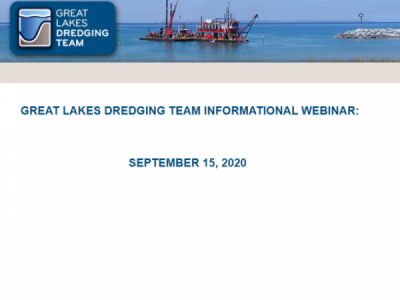
Posted on September 29, 2020
By Carrie Gentile – Staff Writer DredgeWire
Over 160 stakeholders virtually attended the Great Lakes Dredging Team’s information web seminar last week with much of the focus on beneficial uses of dredged materials.
Dave Knight of the Commission Great Lakes Dredging Team (GLDT), Thomas Crane, deputy director of the Great Lakes Commission and Karen G. Keil, environmental toxicologist at the Corps of Engineers opened the seminar with a look at the technical committee’s focus and priorities. They include advancing dredging technology and dredged material management in the Great Lake and connecting channels.
The GLDT’s technical committee, headed by Dr. Jennifer Miller, environmental engineer at the Corps of Engineers, and Dr. Scudder Mackey, chief of the office of Coastal Management at the Ohio Department of Natural Resources, held a discussion of the committee ’s proposed 2020-2021 work plan. This covers many aspects of dredged material including “lessons learned,” environmental evaluations and management, regulatory issues and federal requirements. The technical team will also explore strategies for modifying environmental dredging windows in Lake Michigan for a symposium planned for 2021 in Chicago.
Dr. Keil announced during her presentation that the “Great Lakes Beneficial Use Testing Manual” will be ready for publication next year following a review of the final draft.
In March 2019, the GLDT published the first draft of the “Environmental Evaluation and Management of Dredged Material for Beneficial Use: A Regional Manual for the Great Lakes.” After receiving feedback from dredging stakeholders, the technical team revised the manual and sent a final draft to the Corp’s ERDC (Engineer Research and Development Center) and GLDT for review, bearing in mind consistency and national perspective. The final product is slated to be published next year.
The purpose of the manual is to arrive at an agreed upon set of ground rules for evaluating the environmental suitability of dredged material for a variety of beneficial uses. The team working on the manual consolidated federal and state environmental guidance into one comprehensive resource. It incorporates the best available technical guidance on how to evaluate dredged material for beneficial use.
Dr. Keil’s presentation included some of the major changes made to the draft document including expanding regulatory overview to include NHPA (National Historic Preservation Act) and natural resource damage assessment and restoration; and expanding the discussion on NEPA (National Environmental Policy Act.) Some revisions were also made in both the aquatic and upland placement evaluations sections.
The draft manual will be posted to the GLDT website while ERDC is reviewing and editing it. Once it is final next year, GLDT will be notified that the manual is available at the ERDC website: https://dots.el.erdc.dren.mil/.
Attendees and stakeholders also heard from two other researchers: Dr. Andrew McQueen from the Corps of Engineers Research and Development Center, who presented the finding of his literature review regarding the fate and effects of microcystin toxins (which can be formed during harmful algal blooms) in nearshore and upland environments. This may affect upland beneficial use of dredged material coming from waters impacted by harmful algal blooms. The final presentation was given by Dr. Angélica Vázquez-Ortega of Bowling Green State University who presented her research on whether dredge sediment can successfully augment farm soil. She conducted a series of tests to find its effect on soil health and the soybean crop.
She began the presentation noting the urgency to find beneficial uses is even greater now that open lake disposal of dredge material is prohibited on Lake Erie in Ohio.
Dr. Vázquez-Ortega and her team of students used de-watered dredged sediment from the Great Lakes Dredged Material Center for Innovation and farm soil from a legacy phosphorous farm site in Oregon, Ohio. She explained the soils were thoroughly mixed and separated into four different soil blends – 100% farm soil, 90% farm soil to 10% dredged sediment, 80% farm soil to 20% dredged sediment, and 100% dredged sediment.
Soybeans were planted in half the buckets. After the crops grew, the group conducted their tests and found that dredged sediment amendment improved the quality of the farm soil by providing additional soil organic matter, increasing the cation exchange capacity, calcium and pH. Conversely, the increase in dredged sediment decreased phosphorous in the legacy farm soil. Nutrient loss in the percolated solutions showed no significant changes when compared to the percolated solutions in the 100% farm soil treatment, indicating no significant contribution to the export of nutrients into waterways.
“Our study showed that adding dredged sediment to farm soil improved the farm soil health and showed no negative environmental impacts with respect to additional nutrient loss,” she said.
Copies of all the presentations from the meeting can be found
here.

(L-R) Karen G. Keil, Dave Knight and Thomas Crane





